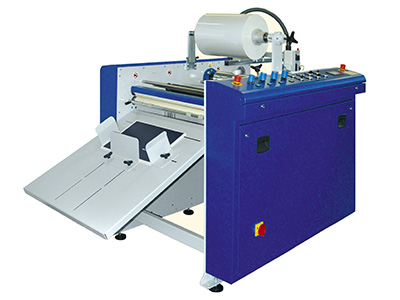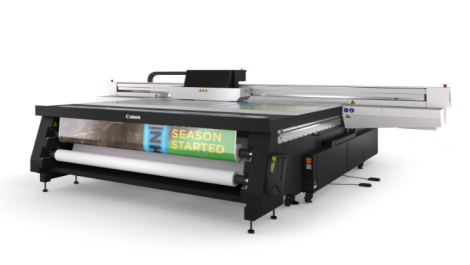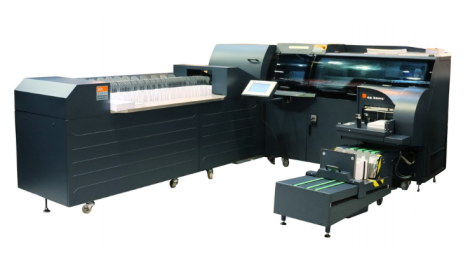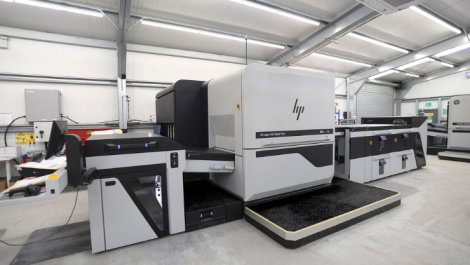Adding a coating or laminate is an attractive way to add value to a job. Nessan Cleary catches up on the latest developments.
Most digital printing is used for either personalisation or short run fast turnaround work, both of which tend to be fairly high value propositions. In many instances, improving the look and feel of these pages will also increase their value, leading to higher profit margins. The most common way of doing this is to add a coating or laminate.
When it comes to coating, there’s a choice between water-based and UV curable coatings.
Michael Barisonek, vice president of sales and marketing for Epic, explains: ‘Water-based is a standard on offset but is about 40% solid and is an acrylic emulsion so it dries with heat and doesn’t have the same degree of gloss. It doesn’t have a residual odour and so is required in a lot of packaging applications.’
Mr Barisonek estimates that water-based coatings are about a quarter of the cost of UV, but in recent years we’ve also seen a number of coaters aimed specifically at the lower volume on-demand digital printer, mainly using UV coatings. Generally speaking, UV cures to a reasonably solid finish, giving good scratch resistance. UV coaters are also easier to clean and maintain. However, you do have to match the right formulation to the printing process in use, to take account of issues such as fuser oil.
These coatings can help improve the image quality of digital prints, making them indistinguishable from litho pages, but they also give better resistance to rubbing and scratching, useful for applications such as direct mail where the pages have to go through the rigours of the postal system. Many coating units can be fitted with patterned rollers that give a textured finish, commonly a linen or canvas effect.
So coatings are mainly about protecting and enhancing the image. Laminate, meaning a plastic film applied over print, gives even better protection but costs much more. It’s also used to change the feel and bulk of an sheet.
Quen Baum, managing director of Morgana, points out that there’s quite a lot of skill needed to run a laminating machine, adding: ‘The skill level necessary to run a coater is pretty minimal because it largely is a sheet of stock going through rollers with a liquid dripped on it and then it’s fed into a set of UV lamps so it’s dried.’
Another benefit of UV coating is that you don’t need to stock laminate films in different weights and textures. But the big advantage in an eco-conscious age is that coatings are recyclable where laminates are plastic and so not easily recyclable.
However, laminating is still popular in some applications, particularly for book covers. John Gilmore, managing director of Autobond, says that laminating has an edge because of the image quality, saying: ‘A lot of people like the feel of a laminate, especially the matt soft touch feel.’ The company has produced a roller flood coater but found that people preferred to laminate once new softer matte films were available.
Laminators
Autobond makes heavy duty film laminators in the UK, many fitted with Heidelberg sheet feeders. Its latest model, introduced at drupa, is a B2 laminator, the Micro 52 SD TP. This aimed at the short run entry-level market, and uses technology borrowed from its Mini SD T series. It runs at 25 metres per minute (mpm), equivalent to around 2000 B2 or 4500 B3 sheets per hour. It’s a compact machine, with a footprint of just 2 x 1 metres, yet it has perfecting for double-sided lamination.
The D&K Group produces all sorts and sizes of laminators from tabletop to wide formats. These include B2 models that look suitable for some of the new B2 digital presses when deliveries start. For example the B2 Jupiter, introduced in 2007, is a fully automated model for sheets up to 540 x 740 mm and 350 g/m2. It’s mainly aimed at the print-on-demand market. It runs at 25 mpm, though there is a faster, 35 mpm version and a the DS double-sided single-pass model introduced at Ipex 2010. It comes with an offset style pile feeder and separator and also includes inline slitting.
Jupiters can handle digitally printed work as well as litho, thanks to an infeed with adjustable pressure. For speedy film changes, the film rolls are locked pneumatically into place via an airline. A jogger feed is standard, but an automatic stacker can be used for longer runs and feeding directly off pallets. A cheaper compact Europa B2 model, based on the Jupiter, runs at 15 mpm (pictured at the top of this article). There’s a semi-automated model, Pegasus, for lower volumes up to 10 mpm.
Friedheim sells the Komfi range of thermal laminators, in a range of sizes from the big Sirius, intended for medium and large jobs up to B0 format, down to the compact Amiga 36 for small orders up to B3 format.
Amiga 36 is aimed at digital print work and can laminate up to 2800 A4 sheets per hour in basic configuration (with a bottom suction feeder), or up to 3000 sheets with the optional Komfi top feeding head. Sheets are separated automatically via build in perforator. A double-sided modification is also offered. Also optional are a film slitter and an additional perforator.
There is also a B2 format Amiga intended for small to medium runs, and the Delta and faster Delta Plus models, also B2 but for longer runs. The Sagitta models are B1 format, with several variations including one that also incorporates embossing.
GBC produces a wide range of wide format and desktop laminators, as well as the 5031TS roll laminator for print finishing applications. This takes sheets up to 76 x 122 cm and laminates film up to 250 microns thick. It can produce up to 11.45 mpm and comes with three slitters for edge centre slitting of two-up jobs. It can be used offline or in combination with a feeder and cutter.
IFS sells the Foliant line of laminators including the Gemini C400. The semi-automatic C400S is the entry-level model, suitable for both litho and digital work. It’s a B3 roll laminator with feeding table and inline separator and runs at 15 mpm. The C400A is a fully automatic B3 line with a separator and feeder.
Terry Cooper Services is now UK distributor for Barcelona based Bagel Systems’ three thermal laminators, which are said to have high build quality and compact footprints. These are the hand fed B3 Minlam for 15 mpm, hand or auto fed B2 Digifav for 22 mpm and hand or auto fed B1 Kikuzen for longer runs. All use Technichrom oil filled heaters for energy reduction. They’re said to be compatible with 95% of digital printers.
Vivid makes a range of mainly wide format laminators, but its smaller format aheet fed Matrix range is popular with digital printers. There are five models in the series, taking films from 460 mm wide to 700 mm. Some models are semi-automatic, while others offer double-sided lamination.
On the wide format side, Vivid makes the Easymount range of hot and cold mounting laminators. These take films ranging from 650 mm to 2100 mm. The bigger models are more robust and offer more features such as double hot rollers.
UV coaters
UV coaters used to be too expensive for most printers, so they were mostly sold to trade service houses. However they’ve come down in price in recent years and some being marketed directly to print companies.
For instance Encore Machinery sells the Korean Kisun range, with starting prices around £11,000 for the 432 mm wide hand-fed model. The Compact Digi UV coater is 330 mm wide but with push button controls for £14,750 and there’s an autoloading model with deep pile feeder and touch screen controls for £21,750.
Morgana sells the DigiCoater, which includes both 33 cm and 52 cm models. These are mostly used for very short runs, with most users hand feeding sheets. However, feeders and stackers are available, plus a choice of one, two or three sets of tanks.
There’s a version with tanks and an infrared dryer for primers, which is useful for certain processes, such as HP Indigo’s new one-shot feature, which relies on having primed media. Morgana’s managing director Quen Baum says that the machines have been designed to be easy to use: ‘A lot of people in the digital segment are not heavily skilled printers. So all of our machines have automatic wash up. One of the difficulties with UV is that it has to be kept meticulously clean or it will affect the quality.’
Drytac is probably best known as a maker of lamination films and JetMounter and HotPress lamination machines, but it also makes UV coaters, including the 304 mm wide DocuMate Plus for on-demand printing. It has an infrared dryer to work with high oil toners.
Its VersaCoater range includes the latest XL 80 for large format work. It runs at 33 mpm and has a roll-to-roll option. Uniquely, it has a white ink feature for creating backlit displays.
Duplo offers the Ultra 205A UV Coater, designed for both digital and offset prints. It takes sheets up to 521 mm wide and 350 g/m2. It runs at 40 metres per minute. It’s highly automated, having some 50 memory settings. There’s a choice of gloss, matt or silk finishes, and a jam detector that lifts the UV lamp out of the paper path. There’s also an entry level version, the Ultra 200A.
In the Friedheim UK distribution stable, Hunkeler showed a neat primer coater module called PC7 at drupa that can be used inline with a press, either before printing as a primer, or after printing as a UV coater. The company says it can also be used to precoat papers for inkjet printers.
Komfi, also sold via Friedheim, has a flood coater, the B2 Fullmatic UV, with automatic sheet feeding and optional sheet stackers and jogging table. It runs at 30 mpm and takes papers from 115 to 350 g/m2.
MGI Group makes a flood coater, UVarnish, designed for digital and litho prints as well as plastics, making it useful for applications such as packaging. It takes materials from 150 to 500 g/m2, and from 14 x 29 cm up to 36 x 52 cm with an option for longer sheets. It can handle up to 2400 sheets per hour and is said to be easy to use.
TechPrint Services sells the American Epic range of coaters. There are several options, including some that can be added to an offset press. For digital print, there’s the CT660, an offline coating system for 4000 sheets per hour in sizes up to 508 x 660 mm. It uses a flexo plate with anilox metering, allowing quick changeover between UV and aqueous fluids. There’s a choice of gloss, matte, satin metallic or pearl finishes. Spot coating is pssible using a hand-cut flexo plate. It can also prime substrates for HP Indigo printers.
Epic developed the system after being by Xerox to produce an inline coating system for iGen presses, called the CTi-635. Xerox uses it together with a buffering stacker and custom die cutter as part of a folding carton solution.
It also makes the WebCoat 350m, which is used in-line with the HP T300 series of big inkjet web presses, running at the rated speed of the press with single or double-sided coating. HP has hinted that Epic is developing a wider version for its T400 series.
Spot UV
The introduction of inkjet digital presses has also seen the development of a handful of inkjets intended specifically to apply spot UV coating.
Autobond has developed its own inkjet based spot UV coater, which it calls SUV, originally to run inline with its 36 cm Mini 36T model laminator and now extended for 52 cm models. It uses Xaar 1001 inkjet heads and cool LED curing. It’s aimed at digital book printing and photobook markets, allowing customers to put spot gloss over matt laminate.
Some people need spot UV on both sides, which can’t be done inline with a laminator, so the company now offers the standalone B2 52 SUV-SDF with its own Stahl suction drum feeder. It is also developing a 74 cm wide inline spot UV coater and says that several big book printers are looking at running it inline with a press.
Friedheim sells the Komfi Spotmatic, a spot UV machine that can produce up to 20 metres per minute. It has 15 inkjet heads and takes sheets up to B2 size and 600 g/m2 thickness. It comes with automatic sheet feeding, UV drying and stacking with a jogging table or an automatic stacker.
At drupa 2008 MGI showed a prototype inkjet based spot UV coater called JETvarnish, for various levels of gloss finish or security coatings. The production machine takes sheets from 21 x 30 cm up to 52 x 105 cm. This was used to produce Digital Printer’s May 2011 cover (see here). At drupa 2012 it unveiled a brand new model, JETvarnish 3D, which is not only a lot faster (up to 3000 B2 sheets per hour), but it can build up raised images to give embossed and textured effects. It’s due for delivery later this year.
Scodix was the first company to offer raised spot UV for special very high gloss
or textured embossing effects. The first B2 model could create raised effects up to 70 microns high: at drupa it introduced two new models, for B3 and B2 sheets, that can build up 250 micron thicknesses.
There’s now a choice of B3 as well as B2 sizes, for paper weights from 135 to 675 g/m2 (or up to 700 microns thick). A new option called the Rainbow Station applies coloured glitter, aimed at the personalised greetings card and novelty packaging markets.
Digital presses
We should also note that some digital toner presses, such as all Kodak five-unit NexPresses, the Xerox Color 1000 and the Xeikon range, can put down clear toner which can give quite nice spot highlight effects inline.
The effect is not as pronounced as with a spot UV coater, but it’s considerably cheaper for many applications this may be enough. Canon’s low end, low speed C1+ digital press also includes a clear toner.
Kodak sells the Nexglosser, an additional unit that can turn the pearl effect of its clear toner to a high gloss. However at drupa it showed a NexPress with an inline UV flood coater at drupa to free up the fifth unit .
Some of the HP Indigo printers announced at drupa have a raised digital ’embossing’ feature, though it requires multiple passes, which take time and adds extra click charges.
With all the effects we’ve noted here, it largely depends on the application and the volumes involved as to which process is most suitable for your needs.





